Body and space
The Wintringer Chapel - a sculptural triptych by Anne Haring
2008
When I enter the Wintringer Chapel as a visitor, I enter a church space emptied of liturgy. As a structure, in beautiful proportions, it is a fragment of the older and larger church building in Wintringen. The interior of the chapel was restored to the bare masonry, colorless glass was inserted into the large arched openings of the crossing and the stained glass windows.
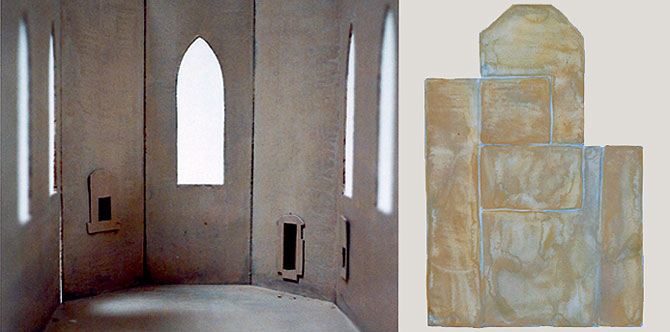
W XXVIII 2008, cardboard/
With this restrained color scheme in the interior, the inherent color of the limestones and sandstones, and the clear glazing, the walls of the chapel become a delicate envelope between the interior and the exterior.
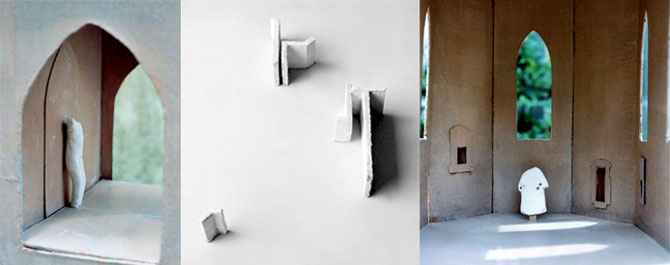
Triptych (model) W XXVIII 2008 - Corpus Christi, modeling clay, height 11cm - Building body, modeling clay, height 9cm - Mantle of the Madonna, modeling clay, height 8cm
Entering the Wintringer Chapel happens much earlier: the chapel between the building parts of today's Wintringer farm and the rudiments of old masonry lets the visitor become one entering already in the outside space. An interplay of inside and outside.
These haunting spatial effects inspired me as a sculptor to develop a work about the Wintringer Chapel. Since April 2008, I am working on the concept Body and Space and its realization as a triptych. In the first step with small sculptures, in the following with room-sized sculptural works.
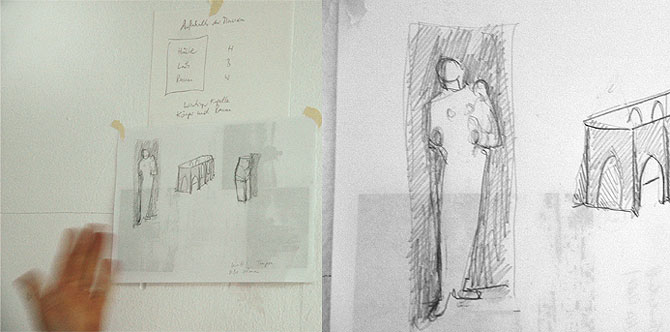
My concept Body and Space includes two essential aspects: The presence and at the same time the absence. On the one hand, the triptych parts have these aspects themselves, on the other hand, they point to the fact that the Wintringer Chapel, the Castle Church in Saarbrücken (Wintringer Madonna and Corpus Christi, Old Collection) and my studio are spatially separated. It is also part of the concept Body and Space that my sculptural works are not shown on site in the Wintringer Chapel, that is, you, as an interested Internet user, are not prepared for an exhibition in the Wintringer Chapel. Go to the castle church, go to the Wintringer Chapel and accompany the work process in extra muros until August 2009.
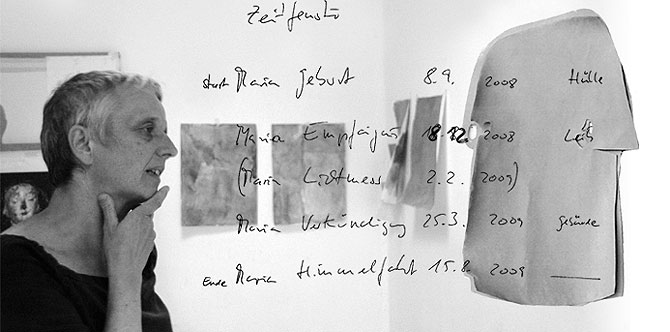
Blnr. 40 6/2008, paper/
In extra muros the working process on the triptych was shown with photos from my studio on the Internet in the period from September 8, 2008 to August 15, 2009.
The mantle of the Madonna
The Wintringer Madonna has an outside gilded and inside blue mantle over a red robe. The spatial presence of the wooden sculpture lies in its depicted material envelopment of mantle and robe. Her corporeality consists in a suggestion of her female figure, convex forms arching the robe. The polychromy of her cloak and robe, however, makes one forget the body as a plastic volume. The cloak is one with her body, the cloak is her shell, her own body unapproachable.
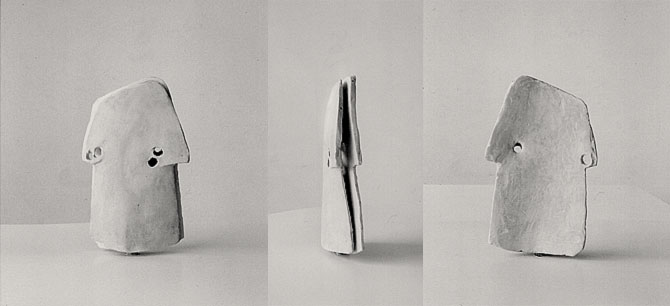
H XXXVIII 2008 - ytong/
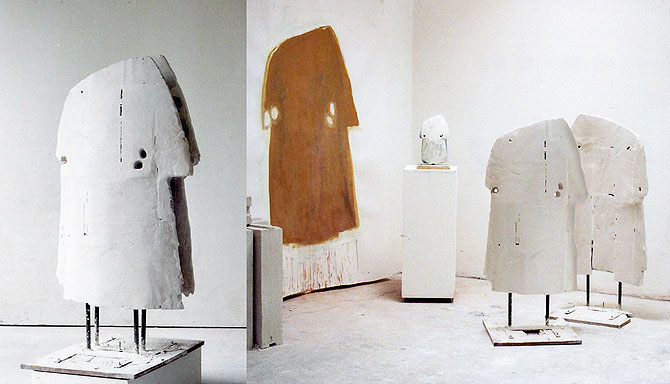
H XXXIX, 2-part, gas concrete, total height approx. 125 cm, studio photo September 2008

Color samples for H XXXIX, tempera/
The two-tone color of the mantle of the Wintringen Madonna thematizes a color contrast that has a supporting and invigorating color effect - gold/ochre and blue. In its tonal possibilities, it ranges from tonal-equal to a strong light-dark contrast.
For my spatial perception it is crucial that the colorfulness of a sculpture does not reach into the space beyond the actual material volume, but creates a unity of body and its (surface) effect. I achieve this through a matte, non-glossy application of color with gouache and tempera, as well as a glazing technique that allows the actual monochrome colorfulnesses - gold/ochre and blue - depth and breathing.
The exact reproduction of these colors is only possible to a limited extent via photography and screen.
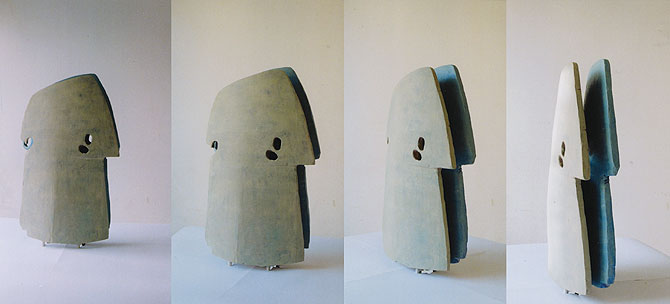
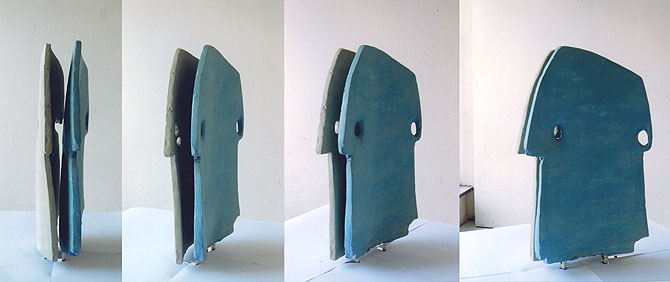
H XXXIX, 2-part, gas concrete/
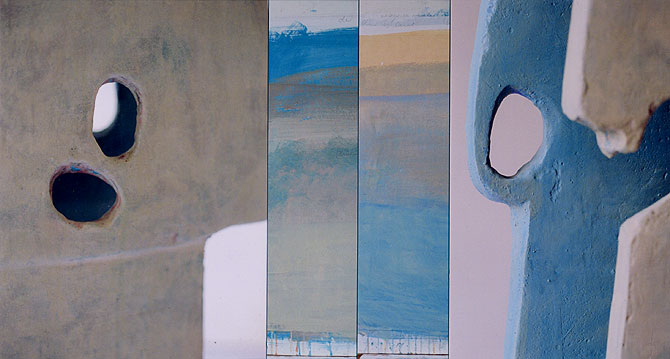
H XXXIX, 2-part, detail - color samples on paper - H XXXIX, detail, February 2009
The working process on the plastic form is largely finished. The color effect is a new development of the plastic form and can only be judged well under daylight conditions. The still pending color changes, in fine nuances, I will not document here on the Internet. As already mentioned, photography and screen are not reliable in terms of color reproduction.
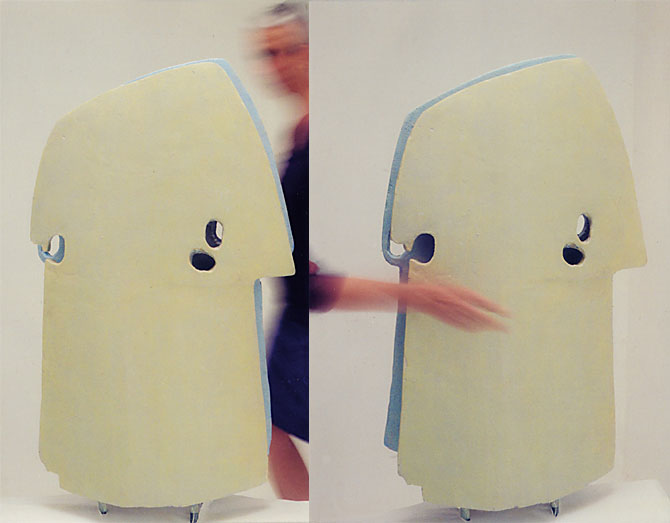
H XXXIX, 2-part, gas concrete/
The found fragment Corpus Christi
The fragment of a found figural sculpture, a Corpus Christi, shows the abdomen, hip and thigh. A bend is clearly designed; the tension of an upright body is missing. With the upper body leaning forward, the figure's center of gravity would not be supported by the base that the leg axes describe. Since the fragment lacks arms and an upper torso, the question remains whether this unstatic moment of the figure had been balanced with the arms. The Corpus Christi, his body, points to the existence of a larger static context.
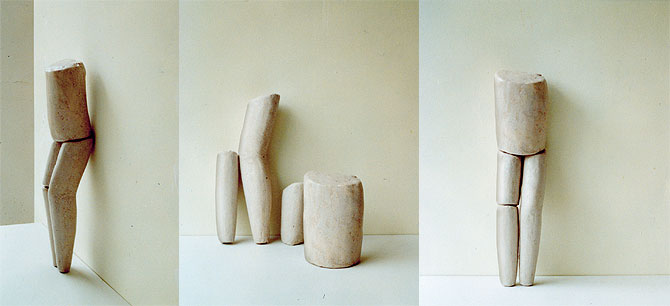
B XXV, 4-part, gas concrete/
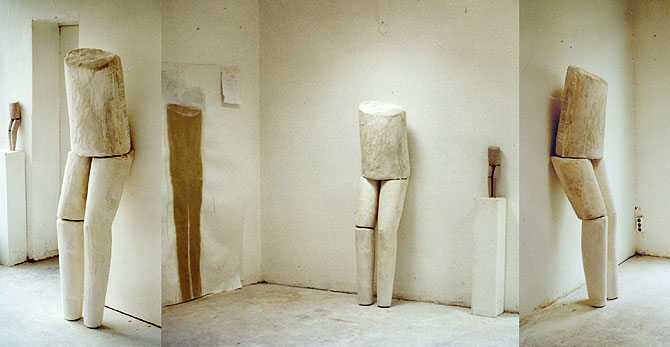
B XXVI, 4-part, gas concrete/
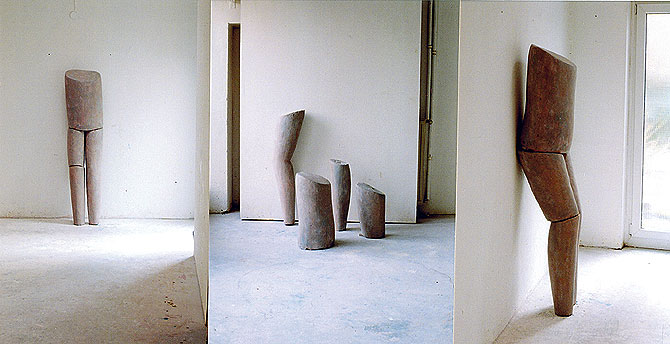
B XXVI, 4-part, gas concrete/
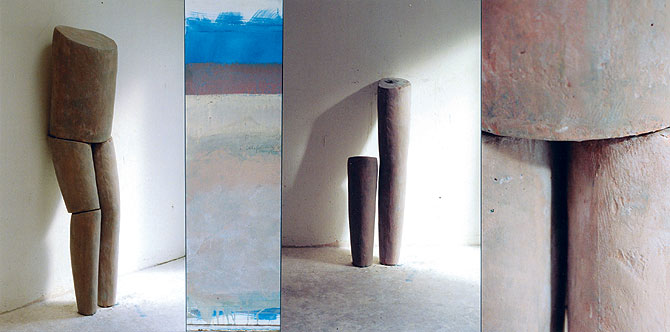
B XXVI, 4-part - color samples on paper - B XXVI, detail, February 2009
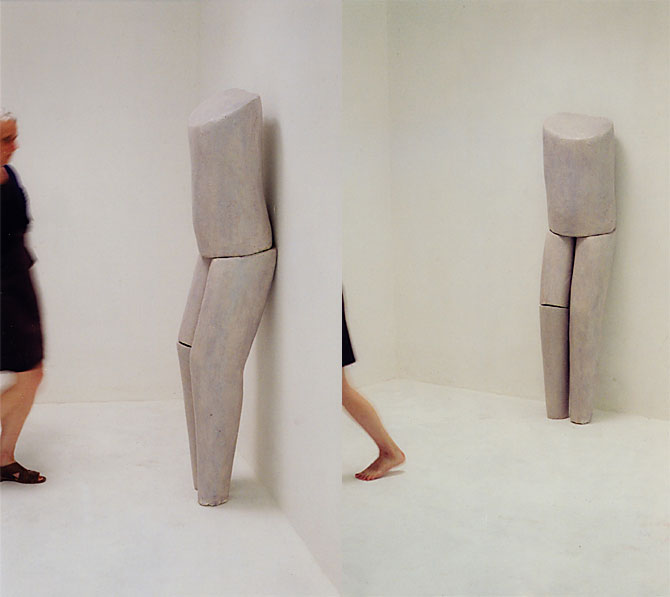
B XXIV, 4-part, gas concrete/gypsum, emulsion paint, total height 175 cm, August 2009
The structure Wintringer Chapel
In the historical process of its various structural forms, the church building developed around a center, the former crossing. It was and is a base area that has been continuously built over throughout the entire development of the building. As if from a center, the church building expanded and contracted from it. Today, a closed wall enclosure forms the building volume of the Wintringer Chapel, wall remnants form spatial boundaries on the historic floor plan - present and absent building volumes.
For a better spatial understanding of the photographs, I give the cardinal directions according to the historical and present floor plan.
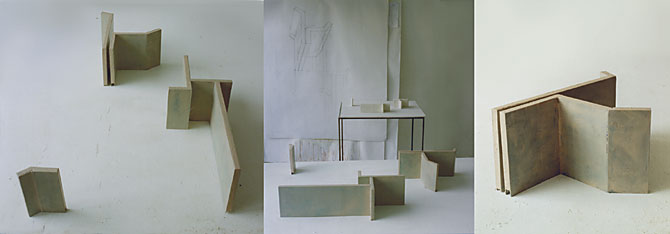
Wall panels XXIX - XXXI, total 5 parts, MDF/
left: View towards east, center: View towards north, right: View towards northeast
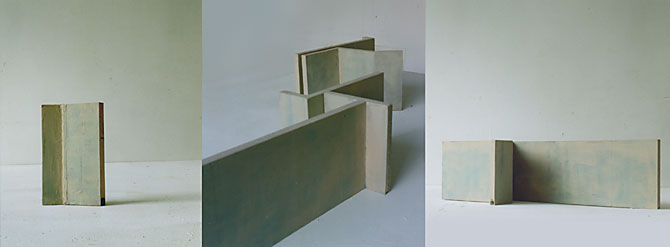
Wall panel XXIX, wall panel XXX (front) and XXXI (back), wall panel XXX, MDF/
left: View towards north-northeast, middle: View towards northeast, right: View towards southeast.
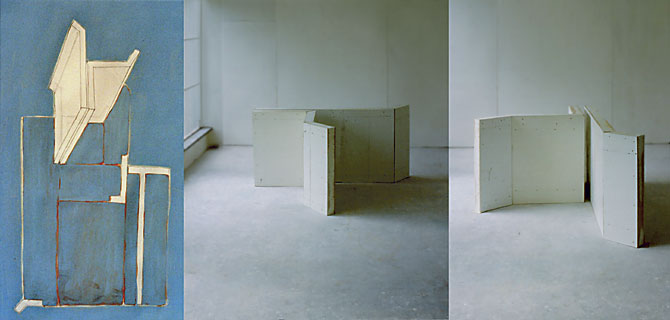
Sheet number 124, tempera, 97 cm x 60 cm, wall panel XXXII, 2 parts, MDF, wall height 94,5 cm
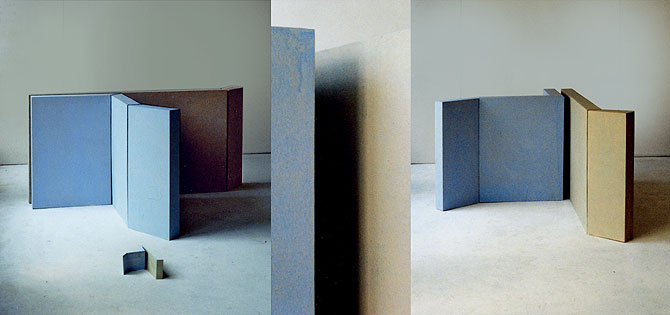
Wall panel XXXII, 2 parts, MDF/
dispersion, wall height 94.5 cm, June 2009
left: View towards north, center: Detail, right: View against west
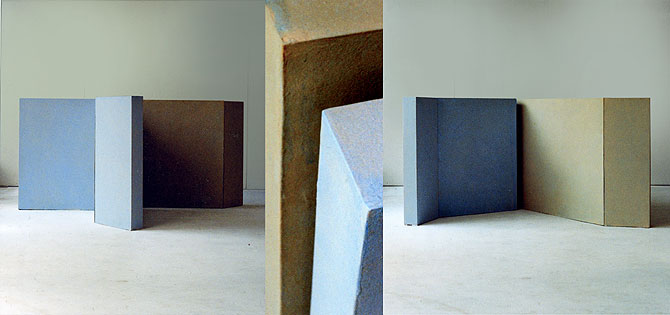
Wall panel XXXII, 2 parts, MDF/
dispersion, wall height 94.5 cm, June 2009
left: View towards north, center: Detail, right: View against northwest
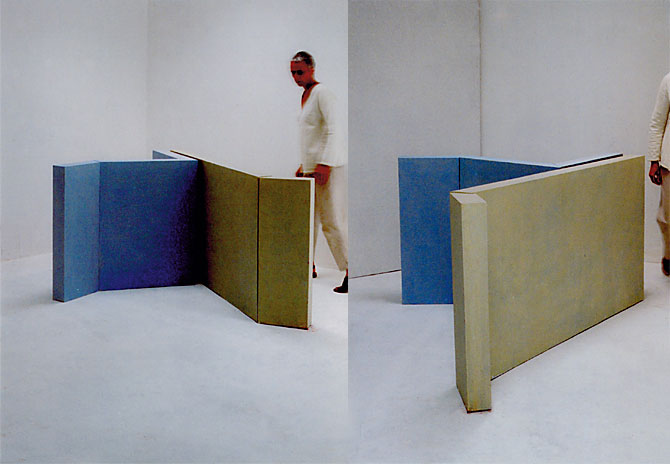
W XXXII, 2-part, MDF, emulsion paint, wall height 94.5 cm, August 2009
Epilog
You have in extra muros been able to follow the process of a plastic work, which is not normally seen, because usually only the results of artistic works are exhibited in spaces such as galleries and museums. Since I have put the photo documentation in extra muros only a few explanatory words to the image sequences, resulted for you perhaps more questions than desired answers. It was and is of course my concept, you not with too many explanations distracting to a finished result.
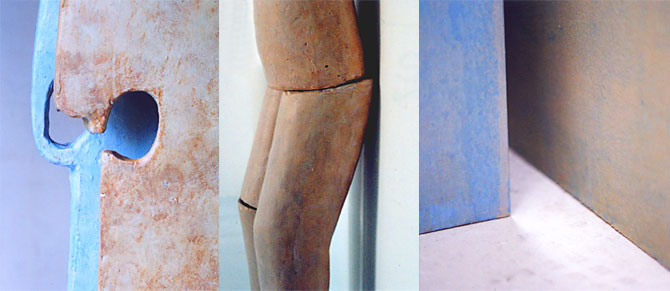
Body and space are two real, factual events of three-dimensionality. For me there is an immediate conditionality of both, which drives me very much as a sculptor: Space is space by virtue of the fact that there is room in it for a completed body, and the viewing of a body implies a space. That is, the existence of a space is proven simply by entering it, by my body. This stands in contrast to an infinite spatial expanse and an infinite material surface, which together cannot express a relation, which we could encounter as experiencers.
From this basic fascination with body and space, I developed in the encounter with the Wintringer Chapel the concept A sculptural triptych, to be able to address this relationality in a coherent work with the questions:
In which tectonic position and deformation does a plastic surface describe the presence of a - not naked - body?
Do I grasp the static element of my body in the presence of the crucifixion image?
When we enter and walk through rooms, do we only perceive their functionality, their purpose?
Do we perceive the colorfulness of materials in spatial events and plastic volumes as immanent to form at all?
The work with the place Wintringer Chapel has brought together for me in a very intense form all four, seemingly independent questions into a complex about body and space.
